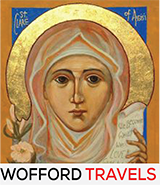Wofford Travels – 2018-10-09 – Budapest, Hungary
Budapest – Day 4
We left our hotel at 10:30 and took the metro to the Great Synagogue. Budapest’s gorgeous synagogue is the biggest in Europe, and the second biggest in the world (after the Temple Emanu-El of New York). This visit entails three activities: touring its ornately decorated interior, exploring it’s attached museum, which offers a concise lesson in the Jewish faith, and lingering in the memorial garden, with its weeping willow Tree of Life sculpture (each slender leaf had a name on it), and other poignant monuments. An added feature for us was a presentation of Jewish klezmer music, with a singer, violin, clarinet, guitar, upright bass, and drummer.
We went first to the synagogue’s 45-minute English-language tour. (There were numerous multi-language tours being given simultaneously.) The synagogue was built in 1859 just outside the city limits at that time. The Jews in Budapest held strong to their faith, yet still wanted to demonstrate how well they were integrated into the greater community. So, this temple was an attempt, in part, to impress the Gentiles. A non-Jewish Austrian architect was commissioned to design one that would top the one recently built in Vienna. The temple is loosely based on the Temple of Solomon in Jerusalem, which is why it has two large towers, not typical in other temples. The towers and rosette window helped the temple resemble Christian churches, and was dubbed by one cynic as ” the most beautiful Catholic synagogue in the world.”
The Interior has a strong Moorish-flavored decor, yet structurally it feels more like a church with a basilica floor plan, three naves, two pulpits, and even a pipe organ, which Franz Liszt played for it’s inauguration.
Following the tour, we went to the Hungarian Jewish Museum, and although it is small, it illuminates the Jewish faith with artifacts and succinct English explanations. The museum has undergone a thorough renovation and is still adding sections.
The Tree of Life and Memorial Garden added to the experience. Some history: During the Soviet siege that ended the Nazi occupation of Budapest in the winter of 1944-1945, many Jews in the ghetto had died of exposure, starvation, and decease. Soon after the Soviets had liberated the city, a mass grave was dug here for an estimated 2,281 Jews. The trees and headstones (donated by survivors) were added later.
There are a number of other memorial features that can make this an almost all-day visit, but we needed to move on to some other sights. One was the Orthodox Synagogue which was built in the Vienna-inspired Succession style in 1912. It was damaged and deserted for decades after World War II until being renovated in 2006. It is greatly opulent and far more typical of synagogue architecture than the Great Synagogue. The temple is used today by a small, but dedicated, local Orthodox community of about 50 people. We were hoping to see the Synagogue at Rumbach Street, but it was under full rennovation during our visit.
For a total change of experience, we visited the Great Market Hall, which took us about an hour. Tom went off his way, and I went off mine. Like so much of Budapest, this market hall (and several others) was built around the millennial celebration year of 1896. The Zsolnay tiles lining the roof are frost proof and harder than stone. Tunnels connect this hall to the Danube, where goods could be unloaded at the customs house and easily transported into the market hall.
The hall has three levels. The ground level has produce stands, bakeries, butcher stalls, heaps of paprika, goose liver, and salamis. Upstairs are stand-eateries and souvenirs. The basement houses a supermarket, a fish market, and piles of pickles. Obviously, we weren’t going to buy any produce. The souvenirs were fairly standard souvenir-style products. There were some fashionable leather goods and clothing and lots and lots of lace (natural and colored) table cloths, table mats, and blouses. If I wasn’t traveling, I would have looked at these items more closely (some would have made nice gifts) but there is no more room to store larger purchases in my luggage.
I decided that it would be a nice finale to Budapest to go for a sight-seeing boat ride. (Tom said it was my call.) So, we walked to the boat dock and purchased the tickets for the 7:30 boat. This gave us time to grab a quick dinner near by. We were definitely looking for something “light.” We had wanted to experience the Gerbeaud cafė and pastry eatery. During the World Wars the well-to-do ladies of Budapest would meet there after shopping their way up to Váci Utca. Today, it’s still the meeting point in Budapest…for tourists at least. As the food is somewhat overpriced, we were satisfied ordering a bowl of goulash soup with accompanying bread and our respective wine and beer.
A quick walk back brought us to our river sight-seeing boat with an audio tour. So for an hour we got to ride on the famous Danube River and get a final review of the buildings, and their history, on it’s banks. You can’t beat seeing a wonderful city on an iconic river at night.
Then, back over the Chain Bridge and day’s end.
Tita
